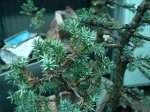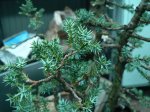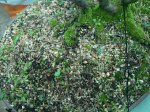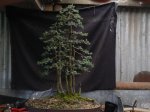More old needle pulling. This probably should be done every 2 or three years on this (J ''blue alps'') and procumbens and rigida etc. They really hang on tight and won't drop naturally until about the 4th year. Removing them helps with any potential back budding and makes wiring a lot more pleasurable too. It's one of the most time consuming things. Much longer than unwiring. These two activities are the most boring things to do. If you don't find them boring, you haven't done enough.


The best part is pulling off the last one.

So apart from a few minor details that's pretty much done. It took about 10 hours over 2 days. What the demos don't mention is the fact that most people probably won't have the time or won't want to invest the time to maintain the tree properly
Of course some are much quicker but some large ones can take a week or more to work. It's not ''finished'', the whole thing will need doing again next year and the wiring will take much longer! So how many trees do you have?



The best part is pulling off the last one.

So apart from a few minor details that's pretty much done. It took about 10 hours over 2 days. What the demos don't mention is the fact that most people probably won't have the time or won't want to invest the time to maintain the tree properly
Of course some are much quicker but some large ones can take a week or more to work. It's not ''finished'', the whole thing will need doing again next year and the wiring will take much longer! So how many trees do you have?




